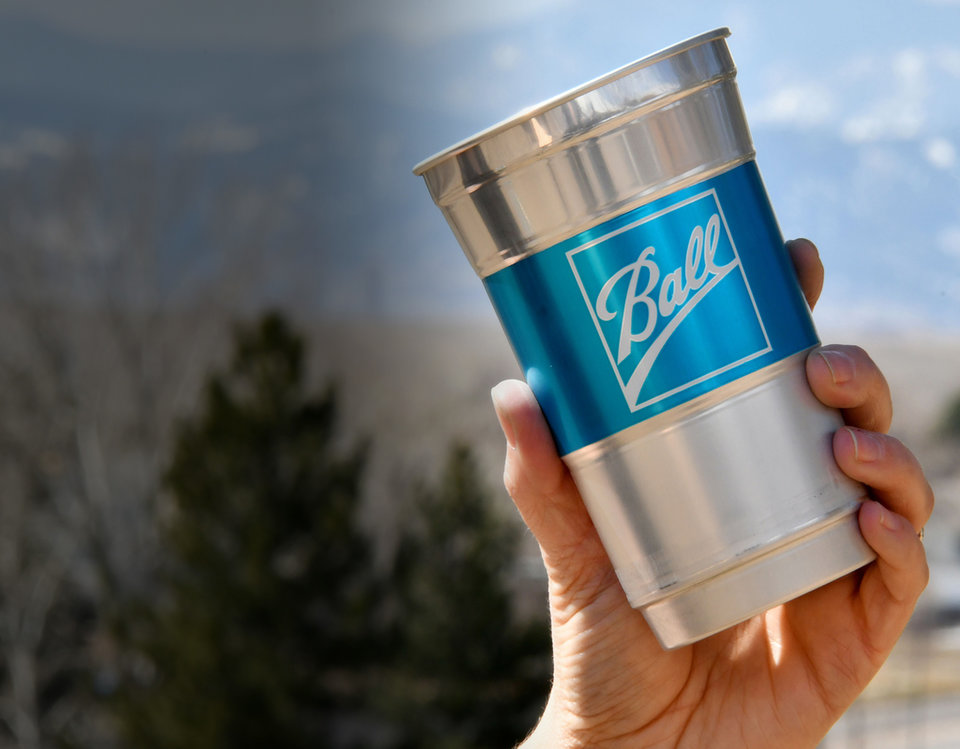METALS
Aluminium, paper, or plastic? The sustainable cup
Ball Corp has been making inroads recently with its new product for live events and foodservice markets: the aluminium cup. But what are the benefits of using metals in lieu of plastic or paper for beverages? Luke Christou investigates.

As the Tampa Bay Buccaneers celebrated capturing the Super Bowl LV trophy, aluminium packaging provider Ball Corporation was celebrating its own victory at the NFL’s showpiece event. For the second year running, beverages at the Super Bowl were served in Ball’s ‘infinitely recyclable’ aluminium cups.
A total of 21,000 cups were available to the 25,000 fans in attendance, offered as a sustainable alternative to single-use plastics in the live event space. According to Ball, 93% of plastic cups used each year end up in landfill, whereas its cups, it says, are recycled and returned to market in approximately 60 days.
According to research conducted by the corporation, 73% of consumers would opt for environmentally friendly containers if given the choice, with half willing to pay a premium. Ball Aluminium Cups have been designed to meet this growing demand for sustainable packaging.
“Each year, hundreds of billions of plastic cups are disposed of globally, contributing to an accelerating global plastic crisis. To date 91% of all plastics ever produced did not get recycled,” Sebastian Siethoff, general manager of Aluminum Cups at Ball, says. “Ball believes introducing aluminium cups, combined with enhanced recycling infrastructure, can combat the plastic pollution crisis.”
Super Bowl LV is just Ball’s latest venture into the sports and live events industry. In October, Arsenal Football Club announced Ball as its official sustainable aluminium packaging partner, as part of a wider global agreement between the producer and Arsenal’s parent company, Kroenke Sports & Entertainment (KSE).
As part of the agreement with KSE, Ball intends to make 100% of the packaging sold at KSE’s Ball Arena in Denver from infinitely recyclable aluminium by 2022, with similar initiatives at Arsenal’s Emirates Stadium expected to follow.
Aluminium’s sustainability credentials
Despite significant efforts to increase the recycling rate of single-use plastics, it still sits some way behind aluminium. Some 75% of aluminium gets recycled in Europe, compared to approximately 40% of plastic waste.
Aluminium also has the advantage of being infinitely recyclable. Aluminium packaging can be recycled time and time again without losing quality, while plastic packaging degrades with time and use, eventually reaching a condition where there is no option but to send it to landfill or incinerator.
“Just like aluminium cans, the aluminium cup can be recycled an infinite number of times without losing quality. In fact, 75% of the aluminium ever produced is still in use today,” Siethoff says.
“Aluminum provides tremendous opportunities for packaging innovation coupled with sustainability, and we’re excited about the cup’s ability to continue helping reduce waste and improve recycling at major sports and entertainment venues, concerts, tailgates and more.”
However, replacing plastic with aluminium isn’t quite as straightforward as it seems.
Virgin aluminium is created through the mining of bauxite rock, a process linked to significant damage to biodiversity and habitats in places such as Malaysia, Brazil, and Ghana.
From bauxite, chemical reactions are used to separate its compounds to produce alumina, which is then dissolved, melted, and passed through a current to create aluminium. This intensive process requires a significant amount of energy to carry out.
According to Reuters, at its most polluting level, aluminium can produces 1,300 grams of carbon dioxide emissions compared to 330 grams produced by a polyethylene terephthalate (PET) plastic bottle of the same size.

Aluminium is produced through the mining of bauxite. Credit: Alexey Rezvykh / Shutterstock.com
With the use of green energy, the environmental cost of aluminium production can be reduced. But while green aluminium is emerging, polluting methods continue to be used to produce aluminium at less cost, which could prove challenging for adoption.
“As regulations and policies vary regionally, some countries still produce most of their energy from coal,” Jock Armstrong, principal consultant for energy services engineering firm Worley explains. “And where there’s cheap energy, there’s cheap aluminium.”
However, producing recycled aluminium is estimated to require just 8% of the energy used to create virgin aluminium. Likewise, with aluminium cans typically contain three times the amount of recycled material compared to PET containers according to the Aluminum Association, recycled aluminium may offer an improvement over plastic.
Despite its positives, with an estimated 371 million tonnes of bauxite produced in 2019 – up 37% since 2016 – the environmental cost of aluminium production still presents a significant issue.
Recycle, replace, or reuse?
Aluminium certainly has its advantages over plastic, as well as its disadvantages. But what other options are there for venues?
Paper offers lower CO2 emissions. However, not only is the paper industry responsible for similar damage to wildlife, local communities, and the environment, but when used to contain beverages, paper cups must be lined with a plastic or bioplastic coating to stop the paper from degrading during use. As a mixed material, the challenge of recycling becomes significantly more difficult.
Bioplastics, plastic-like materials made from natural resources, were once touted as the solution to the plastic crisis. However, organisations such as the Department for Environment, Food and Rural Affairs (Defra) and Keep Britain Tidy have warned against their use.
In many places, the composting facilities required to break down these plastics are unavailable. Likewise, with limited education on these plastics, many consumers are unaware of how to properly dispose of them. As a result, bioplastics often get mixed in with traditional plastics and contaminate the recycling stream.
“I spent 26 years trying everything possible to get recycling to work at live events,” explains Michael Martin, founder of r.Cup.
“At the end of the night, the leaf blowers and shovels come out, the waste is put into bags and goes to landfill. Even when bins were manned, there was still cross-contamination. It was a real epiphany that recycling doesn’t work at live events.”
Overcoming single-use
Rather than replacing plastic, many believe that the solution lies in changing the way that we use it.
“Packaging at live events is for immediate consumption and has a useful life measured in minutes and seconds. If we are truly concerned about extraneous packaging, ought we not be considering reusable, deposit-based systems or BYO [bring your own]?” Capper questions.
“If remembering my durable sip cup was the only way to get a cold beer whilst watching my favourite band, I’m fairly sure I’d remember it.”
r.Cup proposes a system built around reusable plastic cups. After use, attendants are encouraged to discard their cup in a collection bin. These cups are then collected at the end of an event and transported to a washing facility to be cleaned and sterilized in time for the next event.
“We made it really boring and we put a QR code so that people can scan it and learn about the single-use waste crisis, then we work with venues to build a campaign to encourage people to leave the cup behind, sort of like 3D glasses at the movie theatre,” Martin explains.
While some do choose to take the cups home with them as a souvenir, r.Cup estimates that 95-98% of its cups are returned at the end of an event. Martin ‘hates’ that the solution relies on plastic, but believes that it offers the “optimal environmental solution” to eliminating single-use plastic in the live events industry.
Fighting waste, not plastic
The viability of reusable cup systems, however, are often reliant on the venue. r.Cup, for instance, only works with venues and events where all waste, from collection bins to litter on the floor, is hand sorted to ensure its cups aren’t finding their way to landfill.
For Ball, its aluminium cups offer the best possible solution when reusables aren’t an option, due to the material’s durability and recyclability: “The Ball Aluminum Cup™ is a game-changer for sustainability-minded consumers – not only is it lightweight, sturdy and cool to the touch, but it’s also the most sustainable option when reusables aren’t available,” Siethoff insists.
If recycled appropriately, aluminium offers an improvement on plastic — not only is recycling plastic a more complex process, but there is a limit to how much it can be recycled. Yet, as we work to overcome plastic pollution, we must ensure that we’re removing the issue, rather than replacing it.
“As a supremely lightweight and robust material with the most established recycling infrastructure, aluminium is a relatively untapped alternative,” Andrew Capper, creative director for sustainability design firm Echo, says. “However, we also have to ask ourselves: are we swapping one set of sustainability challenges for another?”
Main image credit: Ball Corporation